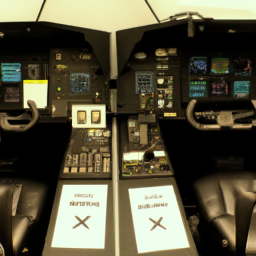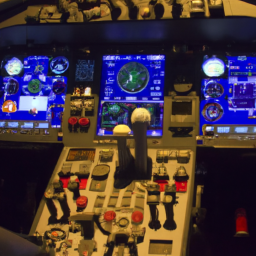In this article, you’ll learn how to recreate real-world weather conditions in your flight simulator. We’ll discuss various methods and tools that you can use to add realism to your flight experience, from utilizing online weather servers to using weather add-ons and plugins. By following these tips, you’ll be able to fly in realistic weather conditions that closely mimic what you would experience in the real world. So, let’s get started and take your flight simulation to the next level!
Understanding the Importance of Real-world Weather Conditions
The Impact of Weather on Flight Simulation
Flying is an exhilarating experience that allows us to explore the skies and experience the thrill of being up in the air. Whether you are a professional pilot or an avid flight simulation enthusiast, you know that a key aspect of a realistic and immersive flying experience lies in the accurate representation of real-world weather conditions.
Weather plays a crucial role in aviation, affecting everything from flight performance and aircraft handling to navigation and safety. It is no wonder that incorporating real-world weather conditions into flight simulators has become a top priority for developers and users alike.
Enhancing Realism in Flight Simulation
Flight simulation software has come a long way over the years, allowing enthusiasts to experience the joys and challenges of flying from the comfort of their own homes. However, one area that has consistently been a topic of discussion and improvement is weather simulation.
Simulating real-world weather conditions adds an essential layer of realism to flight simulation. It enables pilots, whether virtual or real, to develop their skills by training in various weather scenarios, such as rain, snow, fog, or strong winds. This level of realism also helps pilots develop the necessary decision-making skills to handle adverse weather conditions, enhancing their overall flight safety and preparedness.
Weather Data Sources for Flight Simulators
Global Weather Data Providers
To accurately simulate real-world weather conditions, flight simulators rely on various weather data providers. These providers source real-time weather information from meteorological agencies, satellites, weather stations, and other sources worldwide.
One of the most popular global weather data providers is the National Oceanic and Atmospheric Administration (NOAA). NOAA offers various weather data services, enabling flight simulators to access real-time weather condition updates and historical weather data.
Another widely used provider is the Meteorological Aerodrome Reports (METAR) system. METAR provides vital weather information such as temperature, wind speed, wind direction, visibility, cloud cover, and precipitation reports. Flight simulators often integrate METAR data into their weather engines to ensure accurate and up-to-date weather conditions.
Local Weather Data Sources
In addition to global weather data providers, flight simulators also integrate local weather data sources to enhance realism in specific regions. These sources may include local meteorological agencies, airports, and weather stations positioned around the simulated area.
By incorporating local weather data sources, flight simulators can accurately reflect the unique weather patterns and conditions of specific locations. This level of detail allows pilots to experience the nuances of flying in different regions and adapt their flying techniques accordingly.
Integration of Weather Data in Flight Simulators
Using APIs to Fetch Real-time Weather Data
Flight simulation software often utilizes Application Programming Interfaces (APIs) to fetch real-time weather data from various providers. APIs allow the simulation software to establish a connection with the weather data source and fetch the required information.
By utilizing APIs, flight simulators can access real-time weather updates seamlessly. This integration ensures that the weather conditions reflected in the simulator correspond to the actual conditions at the user’s chosen location, enhancing the overall realism of the flight experience.
Implementing Weather Plugins in Flight Simulation Software
Another method used to integrate weather data in flight simulators is through the use of weather plugins. These plugins enhance the software’s weather simulation capabilities by providing additional features, such as improved cloud modeling, more realistic precipitation effects, or enhanced turbulence simulation.
Weather plugins often work in tandem with the flight simulator’s built-in weather engine, supplementing it with more advanced weather simulation algorithms. These plugins can be created by third-party developers or included as part of the original flight simulation software package.
Configuring Real-world Weather Scenarios
Adjusting Wind Speed and Direction
One of the primary factors that contribute to the realism of flight simulation is the accurate representation of wind conditions. Wind speed and direction significantly impact aircraft performance, especially during takeoff, landing, and while flying at different altitudes.
Flight simulators allow users to adjust wind speed and direction based on real-world weather conditions. By aligning the simulated wind with the actual wind conditions, pilots can experience the challenges posed by crosswinds, headwinds, and tailwinds, further enhancing their flying skills.
Manipulating Cloud Cover and Precipitation
Cloud cover and precipitation are key elements of weather simulation in flight simulators. These aspects not only affect visibility but also play a crucial role in creating realistic weather scenarios.
Flight simulation software enables users to adjust cloud cover density and height to match real-world conditions. This feature allows pilots to experience flying through different types of clouds, from fluffy cumulus clouds to towering cumulonimbus clouds associated with thunderstorms.
Similarly, precipitation, such as rain or snow, can be adjusted to recreate the atmospheric conditions encountered in the real world. This level of customization allows pilots to train in adverse weather conditions, preparing them for the challenges they may face during actual flights.
Utilizing Dynamic Weather Systems in Flight Simulation
Simulating Thunderstorms and Extreme Weather Events
Thunderstorms and extreme weather events are a common occurrence in the real world. Simulating these weather phenomena in flight simulators adds significant excitement and challenge to the flying experience.
Flight simulation software often incorporates dynamic weather systems that generate realistic thunderstorms based on real-world weather data. These systems simulate lightning, heavy rain, strong winds, and turbulent conditions, allowing pilots to test their skills in handling adverse weather events.
Recreating Realistic Weather Transitions
Real-world weather conditions are rarely static. They change and evolve over time, creating dynamic and unpredictable scenarios. Flight simulators aim to replicate these transitions to provide an accurate representation of real-world weather patterns.
Advanced flight simulation software utilizes weather engines that simulate the realistic progression of weather conditions, transitioning from calm skies to turbulent atmospheres. These transitions create a more immersive and lifelike experience, enhancing the pilot’s ability to adapt to changing weather conditions.
Understanding Meteorological Effects on Aircraft Performance
The Impact of Temperature and Air Density on Flight Physics
Temperature and air density are crucial variables that affect aircraft performance in real-world aviation. Flight simulation software aims to replicate these effects accurately to provide a realistic flying experience.
As temperature increases, air density decreases, resulting in reduced lift and decreased engine performance. Flight simulators incorporate this phenomenon, allowing pilots to experience the challenges associated with high-temperature environments and understanding the necessary adjustments to maintain adequate lift and thrust.
Effect of Crosswinds and Turbulence on Flight Dynamics
Crosswinds and turbulence significantly impact an aircraft’s handling and stability. Flight simulators account for these factors, enabling pilots to practice their skills in controlling the aircraft during adverse weather conditions.
Simulating crosswinds allows pilots to learn and develop techniques such as crabbing and crosswind corrections during takeoff and landing. Turbulence simulation, on the other hand, helps pilots understand how to anticipate and respond to sudden changes in air movement, enhancing their safety and comfort during flight.
Real-time Weather Updates during Flight Simulation
Utilizing Live Weather APIs
To maintain accuracy and realism throughout a flight simulation, some software provides the option to fetch real-time weather updates during the flight. This feature allows for dynamic weather updates based on the current position of the simulated aircraft.
By utilizing live weather APIs, flight simulators can provide pilots with real-time updates on weather conditions at their current location. This feature allows pilots to monitor changing weather patterns and make informed decisions based on accurate and up-to-date information.
Implementing Weather Radar Systems
In addition to real-time weather updates, flight simulators often include weather radar systems. These systems help pilots visualize and track weather conditions, such as rain, snow, or thunderstorms, in their vicinity.
Weather radar systems provide valuable information about the intensity and proximity of adverse weather, giving pilots the opportunity to navigate around dangerous weather systems. This feature allows pilots to develop situational awareness and make informed decisions for safe and efficient flight planning.
Creating Custom Weather Conditions in Flight Simulation
Designing Unique Weather Phenomena
Apart from replicating real-world weather conditions, flight simulators offer the flexibility to create custom weather phenomena. This feature allows users to experiment with different scenarios, including extreme weather events or unusual atmospheric conditions.
By designing unique weather phenomena, pilots can challenge themselves and test their skills in handling unconventional situations. This feature also adds a layer of creativity and experimentation, allowing users to push the boundaries of traditional flight simulation experiences.
Establishing Local Weather Patterns
Flight simulators also enable users to establish custom local weather patterns. This feature allows pilots to replicate specific weather conditions unique to their chosen region, providing a more accurate representation of flying in that area.
Custom local weather patterns can reflect the unique weather phenomena experienced in different parts of the world, such as monsoons, sea breezes, or mountain wind patterns. This level of customization enhances the overall realism and immersion of the flight simulation experience.
Practical Tips for Simulating Real-world Weather Conditions
Researching Weather Patterns and Phenomena
To further enhance the authenticity of your flight simulation experience, it is essential to research real-world weather patterns and phenomena. Understanding the dynamics of weather systems, such as temperature inversions, frontal systems, or jet streams, can help you create more accurate and challenging weather scenarios in your simulator.
Seeking Guidance from Real-life Pilots and Meteorologists
If you are a serious flight simulation enthusiast aiming for the highest level of realism, consider seeking guidance from real-life pilots and meteorologists. Their expertise and insights can provide valuable information on how to accurately replicate real-world weather conditions and create an authentic flight experience.
By collaborating with professionals in the aviation industry, flight simulation enthusiasts can gain valuable insights into the intricate details of weather patterns, flight performance, and safety considerations. This collaboration enhances their understanding and mastery of flight simulation, taking their experience to new heights.
Conclusion
Simulating real-world weather conditions in a flight simulator is crucial for achieving a truly immersive and realistic flying experience. By integrating weather data sources, utilizing APIs and plugins, and configuring various weather scenarios, flight simulators can replicate the complexities and challenges of real-world weather conditions.
Understanding the impact of weather on flight simulation and its effects on aircraft performance allows pilots to develop essential skills and enhance their overall safety and preparedness. Utilizing dynamic weather systems, real-time weather updates, and customized weather conditions further elevates the flight simulation experience, providing endless possibilities for exploration and learning.
As flight simulation enthusiasts, we have the opportunity to immerse ourselves in an incredibly realistic virtual world, exploring the wonders and uncertainties of the skies. By simulating real-world weather conditions, we can unlock the full potential of this experience and continue to push the boundaries of our flying capabilities. So, fire up your flight simulation software, set the weather conditions to match your desired location, and prepare to embark on a journey through the skies like never before.




